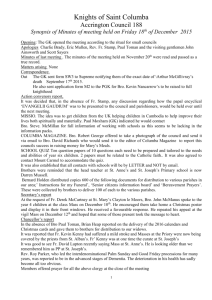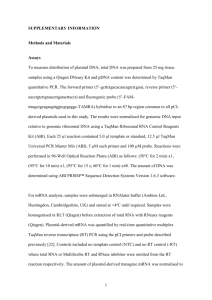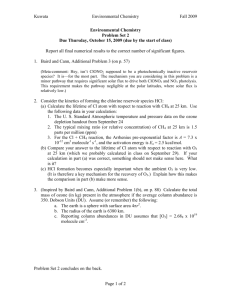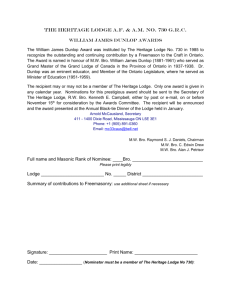bromine oxide formation over the dead sea valley, israel
advertisement
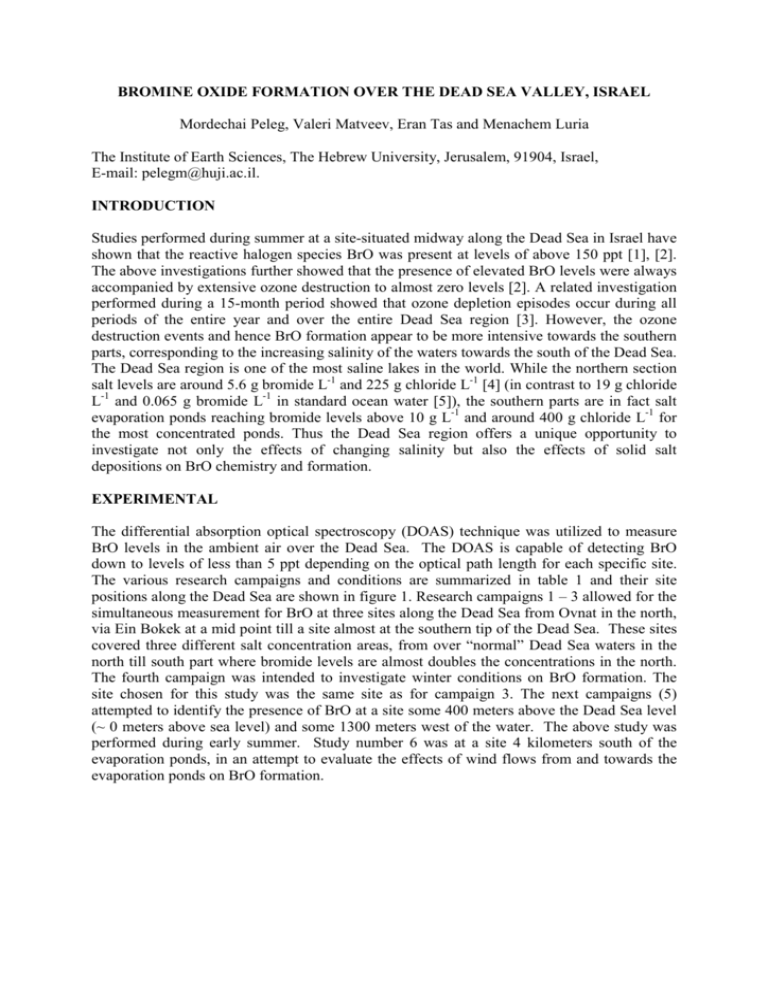
BROMINE OXIDE FORMATION OVER THE DEAD SEA VALLEY, ISRAEL Mordechai Peleg, Valeri Matveev, Eran Tas and Menachem Luria The Institute of Earth Sciences, The Hebrew University, Jerusalem, 91904, Israel, E-mail: pelegm@huji.ac.il. INTRODUCTION Studies performed during summer at a site-situated midway along the Dead Sea in Israel have shown that the reactive halogen species BrO was present at levels of above 150 ppt [1], [2]. The above investigations further showed that the presence of elevated BrO levels were always accompanied by extensive ozone destruction to almost zero levels [2]. A related investigation performed during a 15-month period showed that ozone depletion episodes occur during all periods of the entire year and over the entire Dead Sea region [3]. However, the ozone destruction events and hence BrO formation appear to be more intensive towards the southern parts, corresponding to the increasing salinity of the waters towards the south of the Dead Sea. The Dead Sea region is one of the most saline lakes in the world. While the northern section salt levels are around 5.6 g bromide L-1 and 225 g chloride L-1 [4] (in contrast to 19 g chloride L-1 and 0.065 g bromide L-1 in standard ocean water [5]), the southern parts are in fact salt evaporation ponds reaching bromide levels above 10 g L-1 and around 400 g chloride L-1 for the most concentrated ponds. Thus the Dead Sea region offers a unique opportunity to investigate not only the effects of changing salinity but also the effects of solid salt depositions on BrO chemistry and formation. EXPERIMENTAL The differential absorption optical spectroscopy (DOAS) technique was utilized to measure BrO levels in the ambient air over the Dead Sea. The DOAS is capable of detecting BrO down to levels of less than 5 ppt depending on the optical path length for each specific site. The various research campaigns and conditions are summarized in table 1 and their site positions along the Dead Sea are shown in figure 1. Research campaigns 1 – 3 allowed for the simultaneous measurement for BrO at three sites along the Dead Sea from Ovnat in the north, via Ein Bokek at a mid point till a site almost at the southern tip of the Dead Sea. These sites covered three different salt concentration areas, from over “normal” Dead Sea waters in the north till south part where bromide levels are almost doubles the concentrations in the north. The fourth campaign was intended to investigate winter conditions on BrO formation. The site chosen for this study was the same site as for campaign 3. The next campaigns (5) attempted to identify the presence of BrO at a site some 400 meters above the Dead Sea level (~ 0 meters above sea level) and some 1300 meters west of the water. The above study was performed during early summer. Study number 6 was at a site 4 kilometers south of the evaporation ponds, in an attempt to evaluate the effects of wind flows from and towards the evaporation ponds on BrO formation. RESULTS The results for August 3 for 2001, (figure 2) shows that BrO was observed simultaneously all along the Dead Sea. The highest levels of 120 ppt were observed at the south site over the evaporation ponds while for the other two sites BrO levels of around 60 ppt were observed. It should also be noted that ozone reduction is very strong at the south site, over the evaporation ponds, while only limited ozone reduction was noted for August 3 at the two other sites. Figure 3 shows all of the results for BrO as recorded at the three sites for summer 2001 (campaigns 1-3, see table 1). The results are reported as hourly bins. Also indicated in the graphs are the mean values together with the standard deviation bars for each bin. The results clearly indicate that BrO is formed all over the Dead Sea region during August. The highest BrO levels were observed at Ein Bokek with values of almost 220 ppt, over the evaporation ponds values reaching almost 150 ppt were recorded while in the north at Ovnat maximum levels reached only 120 ppt. The formation of BrO begins in the early morning at around 07:00 (UT+2) for south site over the evaporation ponds, around 08:00 to 09:00 for the mid site and not before 10:00 for the northern Ovnat site. BrO formation continues at all the sites till at least 18:00 in the evening. Measurements performed over the evaporation ponds during winter (campaign 4) observed BrO, above detection limits of 10 ppt, on only 4 of the 9 measuring days. However BrO levels similar to those recorded at the same site during summer were also observed with a maximum level of 140 ppt and an average for all the days of around 60 ppt. Measurements performed during summer 2002 at a site (Metzoke Dragot, campaign 5) showed a daily presence of BrO averaging around 20 to 30 ppt. The maximum BrO level recorded at this elevated site was only 60 ppt. Measurements performed at the Ein Tamar site, (campaign 6) showed BrO maximum values of almost 100 ppt with average levels between 20 to 30 ppt. DISCUSSION The following conclusions can be drawn from the present study. The above results show that BrO is formed all over the entire region of the Dead Sea and is detected even up to an altitude of 400 meters above the water and also at least 4 kilometers south of the Dead Sea. However the frequency and intensity of BrO formation is stronger towards the southern part of the Dead Sea where the salinity of the waters is higher. Additionally due to the high salinity of these waters there are extensive salt deposits in the southern part of the Dead Sea. The winter study has shown that BrO production during the winter at the Dead Sea is similar to that formed during the hot summer although temperatures are half those of summer (20ºC and 35 ºC respectively), and the solar radiation is reduced by at least 30%. Thus solar radiation and temperature are not rate limiting factors in BrO formation. Elevated BrO levels were observed at the Metzoke Dragot site only on those days for which the boundary-mixing layer was limited to less than 300 meters above the measuring site. The limited mixing height apparently restricts the BrO and its precursors from dispersing into the environment and thus slows the build up of measurable BrO levels. The results for the Ein Tamar site showed that BrO was observed not only under northerly wind flows, flows from over the evaporation ponds (see figure 1), but also when the wind flowed from the south. The maximum BrO levels observed were 100 ppt when the winds were from the north as compared to only 55 ppt under southerly winds. The fact that BrO is observed at this site even for air masses coming from the south suggests the following two possibilities. Recirculation of air masses that had previously entrapped the RHS precursors or BrO itself during passage of the air masses over the evaporation ponds/salt pans situated north of the site. If recirculation is not the reason, then it has to be assumed that another source for precursor and BrO production is present. The possibility exists that salt aerosols have been deposited in the vicinity of the Ein Tamar site itself and this is the source of BrO production. All the above suggests that the high level of BrO formation found at the Dead Sea is directly related to the high bromide salt content of the water. The more concentrated the salt in the water or the presence of solid salt deposits, the greater the BrO production. The presence of BrO at the elevated site suggests that BrO or the precursors have a lifetime of at least around one hour. The proposed main mechanism for BrO formation, relevant for the Dead Sea, has been suggested as being the release of reactive halogens from sea salt. The release of bromine (or other halogens) from sea salt is based on the uptake of HOBr on acidic salt surfaces followed by the formation of a halogen molecule. HOBr + Br- +H+ → Br2 + hν → Br2 + H2O 2Br (1) (2) The released halogen atoms then react as follows, 2Br + 2O3 BrO + HO2 → → 2BrO + 2O2 HOBr + O2 (3) (4) 2BrO + H2O + 3O2 (5) Giving rise to the net reaction, BrO + HO2 + Br- + H+ + 2O3 → The above net reaction has been named a `bromine explosion mechanism`. The halogen oxide molecule acts like a catalyst promoting the oxidation of Br- to Br by O3. The present study has further shown that BrO production is always accompanied by reduction in the NO2 concentration levels. At all the measuring sites, NO2 initially present at levels of between 3 and 4 ppb, showed a direct anti correlation with BrO, being reduced to zero levels at BrO above 30 – 40 ppt. While the NO2 concentration is decreased upon BrO formation the NOz value increases proportionally to the NO2 decrease. This would appear to indicate that a reservoir species such as NO2BrO is being formed. Upon termination of BrO formation the reservoir species breaks up releasing the BrO and NO2. REFERENCES [1] Hebestreit, K., Stutz, J., Rosen, D., Matveev, V., Peleg, M., Luria, M., Platt, U., 1999. DOAS measurements of tropospheric BrO in mid Latitudes, Science 283, 55-57. [2] Matveev, V., Peleg, M., Rosen, D., Siman Tov-Alper, D., Stutz, J., Hebestreit, K., Platt, U. Blake, D., Luria M., 2001. Bromine Oxide – Ozone interaction over the Dead Sea. J. Geophys. Res. 106, 10,375-10,387. [3] Niemi, T.M., Z. Ben-Avrahem, and J.R. Gat, (Eds.), 1997, The Dead Sea: The Lake and Its Setting, Oxford Monogr. Geol. Geophys., vol. 36, Oxford Univ. Press, New York. [4] Sverdrup, H.U., M.W. Johnson, and R.H. Fleming, 1942, The Oceans, Their Physics, Chemistry and General Biology, Prentice-Hall, Englewood Cliffs, N.J. No. 1 2 3 4 5 6 Date Site Light Light Comments Direction Path (km) July 27 – Aug. 10, Ovnat (north) NW - SE 2.5 - 4.6 Light path ((LP) over 2001 land, west of the Dead Sea July 20 – Aug. 4, Ein Bokek (mid) W-E 8.5 LP directly over Dead 2001 Sea waters Aug. 2 – Aug. 12, Evaporation ponds W - E 5.8 Summer conditions, LP 2001 DSW (South DS) directly over most concentrated salt ponds Dec. 24, 2001– Evaporation ponds W – E 5.8 Winter conditions, LP Jan. 4, 2002 DSW (South DS) directly over most concentrated salt ponds June 17 – July 8, Metzoke Dragot N–S 4.1 Elevated site (+400 m 2002 above DS); LP over land Aug. 18 – Sept. 2, Ein Tamar SW - NE 5.8 South of evaporation 2002 ponds; LP over land Table 1: Summary of the research campaigns and experimental conditions Qalya 35 34 33 0 36 Ovnat ISRAEL 50 25 Distance (km) Metzoke Dragot (elevated site) Haifa Mitzpeh Shalem N Ein Gedi Hadera Me d sea iterra nea n 32 Nablus Massada Tel-Aviv Ashdod JORDAN Water channel Jerusalem Peninsula Ein Bokek Ashkelon Neveh Zohar Hebron Be'er-Sheva Dead Sea Works Dead Sea 31 EGYPT DOAS site DS South Ein Tamar Evaporation ponds Figure 1: Dead Sea map with research sites August 3 2001 120 Ovnat-North Dead Sea BrO 100 Ozone 80 60 40 20 120 Ein Bokek- Mid Dead Sea BrO (ppt) O3 (ppb) 100 80 60 40 20 120 Evaporation ponds - Dead Sea South 100 80 60 40 20 0 0 1 2 3 4 5 6 7 8 9 10 11 12 13 14 15 16 17 18 19 20 21 22 23 24 Hour (UT + 1) Figure 2: BrO and O3 levels at three Dead Sea sites for August 3, 2001 160 220 Ein Bokek - Mid Dead Sea Ovnat -North Dead Sea 200 140 180 120 160 BrO Levels (ppt) 140 80 60 120 100 80 60 40 40 20 20 0 0 0 2 4 6 8 10 12 14 Hour (UT+2) 16 18 20 22 24 0 2 4 6 8 18 20 22 10 12 14 Hour (UT+2) 180 Evaporation Ponds - South Dead Sea 160 140 120 BrO Levels (ppt) BrO Levels (ppt) 100 100 80 60 40 20 0 0 2 4 6 8 10 12 14 Hour (UT+2) 16 Figure 3: BrO levels at the Dead Sea sites 24 16 18 20 22 24
